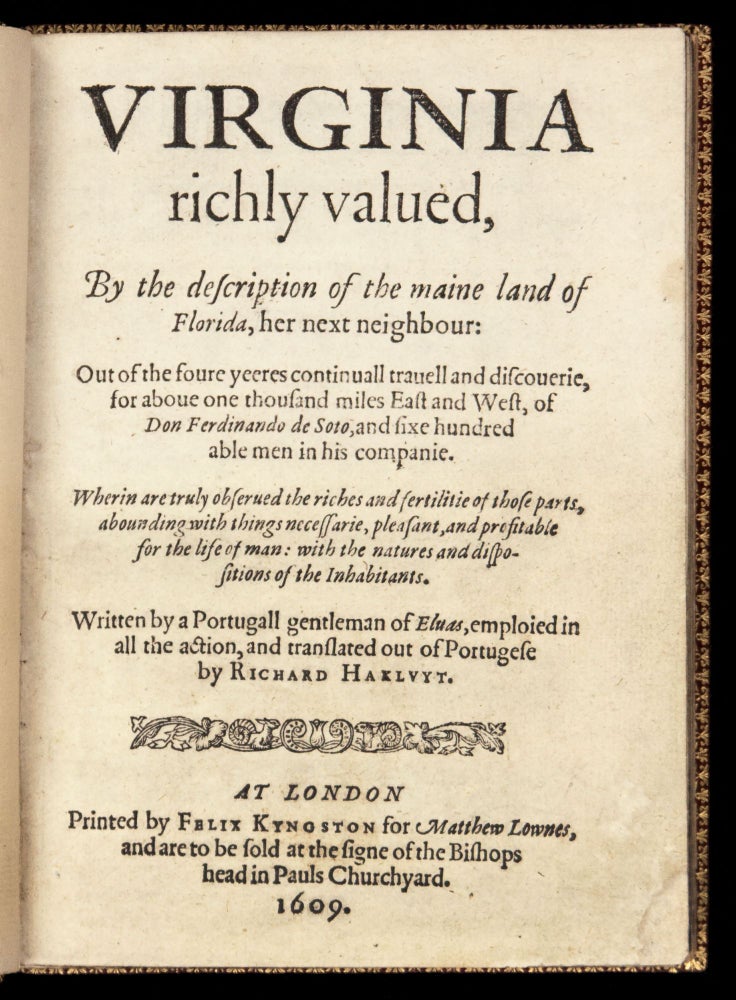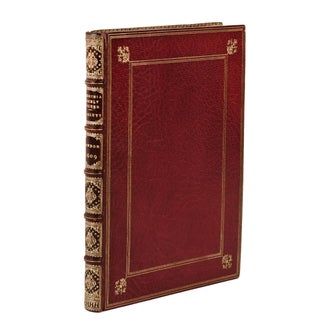Virginia richly valued, by the description of the maine land of Florida, her next nighbour: Out of the four yeeres continuall travel and discoverie, for above one thousand miles East and West, of Done Ferdinando de Soto, and sixe hundred able men in his companie.
4to [17 x 12.5 cm], (4) ff., 180 pp. Bound in 19th-century gilt red morocco signed by Francis Bedford (1799-1883), all edges gilt, gilt turn-ins, marbled endpapers, bookplates of Boise Penrose II on front pastedown and fly leaf, bookplate of Frank S. Streeter on front flyleaf, library stamp of John Carter Brown Library on margin of f. A2r, letter to Penrose concerning sale of this JCB duplicate inserted loosely. Only very minor edge wear to spine. Lower margin a little closely cropped on some leaves touching signatures and catchwords in a few instances, light even toning throughout, excellent. Very scarce first English edition (1609) of this account of Hernando de Soto’s (c. 1500-42) North American expedition (1539-1543), published by Richard Hakluyt (1553-1616) with a view to strengthen the fledgling English colony in Virginia. Settlers arrived at Jamestown only two years before this book was published, and the colony’s fate still very much hung in the balance. Like Hakluyt’s other writings on the colonies, this text was intended to encourage English settlers and to shore up support at home for the expansion of English overseas possessions. Hakluyt hoped that providing De Soto’s narrative to interested parties might orient them to what lay ahead in the New World, and he encouraged investment by assuring readers that “Florida is the richest Countrie of the world” and neighboring Virginia held similar potential. (‘Florida’ at the in the 16th century encompassed much of the American South, some of which was claimed by the 1609 second Virginia Charter just weeks after the publication of Hakluyt’s translation.) The work provides extensive first-hand information concerning De Soto’s landing in Tampa Bay (Spirito Santo), his movement through northern Florida into Georgia and South and North Carolina, and his western turn through the South as far as Texas. Hakluyt’s works – of which the present is the last published during his lifetime – also provided fertile inspiration for Shakespeare and other contemporary writers seduced by the romance of the colonial enterprise. The text is a translation of the Portuguese Relaçam verdadaira dos trabalhos first published in Evora in 1557. The “Gentleman of Elvas” cited in the title as the author of the account has never been satisfactorily identified: Evidently a participant of de Soto’s expedition, he may have been Alvaro Fernandez, whose name appears in related records. According to another theory he was de Soto himself – although he died before the expedition’s return to Mexico. De Soto had amassed a sizeable private wealth from the conquests of lands in Central and South America and set out in 1539 to find a second Peru further north in an area called Terra Florida. His group traveled through an area stretching from today’s Tampa Bay, north to the Appalachian Mountains of North Carolina, and west to Arkansas and Texas, but failed to yield the expected mineral riches. By the time it returned to Mexico in 1543, half its members had died, including de Soto. Hakluyt, however, glosses over the shortcomings of the expedition and stresses the economic potential of the region. “This work… doth yield much light to our enterprise now on foot: whether you desire to know the present and future commodities of our countrie; or the qualities and conditions of the Inhabitants, or what course is best to be taken with them,” he writes in his introduction addressed to “the right honourable, the right worshipfull Counsellors, and others the cheerfull adventurors for the advancement of the Christian and noble plantation in Virginia.” He mentions highlights of the report, including large herds of oxen, great quantities of turquoise, copper and cotton, indigenous methods of salt production, mulberry trees apt for rearing silk worms, to “speake nothing of the severall sorts of passing good grapes for Wine and Raisons” (A3v). Hakluyt was an ordained priest who served as English ambassador in Paris and as private secretary to Sir Robert Cecil, 1st Earl of Salisbury. An early director of the Virginia Company of London, he was the chief sponsor of a petition to James I to issue letters patent to colonize Virginia, which were granted in 1606. According to Church (337), the present “is among the rarest of Hakluyt’s works.” Provenance: John Carter Brown Library. Ink stamp in margin of f. A2r, note by JCB librarian L. C. Wroth on front free endpaper stating that this duplicate was sold on 17 February 1942; typed letter on the same subject and signed Boise Penrose inserted loosely. Bookplates of Boise Penrose and Frank Streeter. *Alden & Landis 609/ 131; Church 337; Sabin 24896; STC 22938.
Sold


